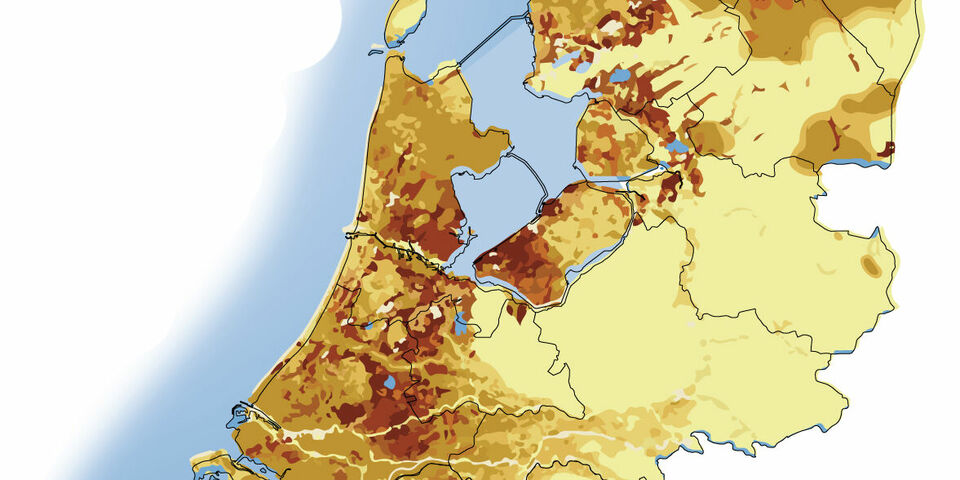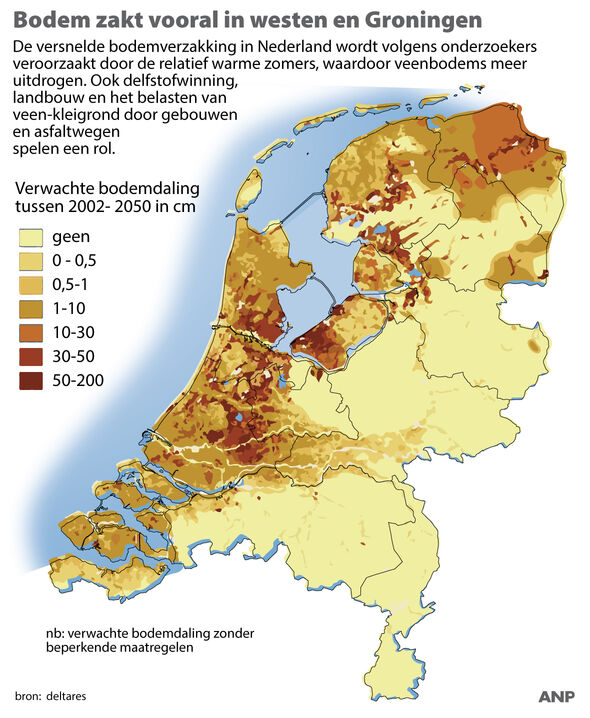Prof Talk| More research needed in battle against subsidence
Early last week the new subsidence map of the Netherlands was presented: the ground beneath our feet is subsiding faster than expected. Faster even than sea levels are rising. It’s a serious problem: sinking houses, rotting pilings and other issues with foundations. How can we combat the damage being done to houses and historic city centers, which materials can reinforce foundations and how can we build sustainable houses in future capable of withstanding this subsidence?
Not only the area where natural gas is extracted in Groningen is colored red on the new subsidence map, but also the Green Heart region and along the Betuweroute railway line. From the latest measurement data produced by the Netherlands Geodetic Commission (NCG) it appears that the Netherlands’ land surface is sinking faster than expected. A worrying observation, believes Rijk Blok. As assistant professor at the Innovative Structural Design group, he conducts research on foundation techniques and teaches soil mechanics.
“Land subsidence is not new. The upper layer of the earth behaves like a jelly pudding and so the land surface is constantly moving. The additional sinking due to gas and salt extraction had already been clearly mapped, but what’s new about these measurement data are the subsidences in the very top layers. The combination of data from satellite radars, GPS and gravity readings creates a very accurate subsidence map. By relating this to the differences in soil type, we can clarify the causes. What is immediately evident is that the land surface is settling quicker than expected. And that we must therefore not wait before taking action.”
Whereas in the north, the land is sinking intermittently due to gas and salt extraction, the pumping of water from peat and clay soils is causing problems in the provinces of North and South Holland, Blok explains. “In areas that are lying below sea level - around Schiphol, for example, by as much as six to seven meters - the water is continually pumped away. Fail to do that and a large part of the Netherlands will be flooded. But the decreasing water pressure is causing the pressure to increase in the fibrous top layer and the granular structures it contains, with settling as the result.”
“In addition, the loads exerted in urban areas by more intensive land use and new buildings are still increasing. In areas rich in peat there’s the added problem of oxidation: the low groundwater table is causing vegetal fibers to die off and the top part of an entire soil layer is being lost. Add to that the massively dry period in the summer, due to which the stable clay and sand layers in the river delta are also settling increasingly. It is thus not surprising that in places other than Groningen foundation piles are at risk of rotting and walls are showing cracks due to settling occurring in an imbalanced way,” says the assistant professor.
Enhance stability
Now that there’s widespread clarity that the subsidence problem is more complex than had been thought, we need to tackle it seriously. “Good public information, looking building by building at the restoration of foundations, and more research on new materials and construction techniques,” says Blok.
“All kinds of techniques are now available for making small-scale reinforcements of the ground or foundations. For example, lime or cement can be added to clay to enhance stability and polyurethane foam can push sagging floors back into the right position. We ourselves are working to develop a foundation floor combined with shock absorbers and thermal insulation. Initially to build earthquake-proof houses in Groningen, but it may be possible to extend this to new builds in other ‘sinking’ regions.”
“For future infrastructure too, such as new roads, we may be able to use lighter materials, exploiting the capacity for buoyancy. Anything to reduce increasing the load - and thus the likelihood of subsidence.”
Biggest issue
“But the biggest issue concerns the groundwater level. Should we reduce this further to maintain the characteristic polder landscape, or will we decide to raise it so that massive damage to historic city centers is avoided where possible? One option is to use drainage pipes in wet seasons to withdraw water and, conversely, in dry periods to add water wherever it is needed. At any rate, we will have to reach a better balance if we want to avoid heading for a landscape of marshes or the deterioration of our monuments.”
About Prof Talk
For anyone seeking answers to topical questions, our academic staff are the ideal oracle. Whether the question concerns the energy transition, automation or the danger posed by hackers, they provide clarity on topical news issues. While Trump would say, “It's only an opinion”, we are highly appreciative, and so once every three weeks we will be publishing Prof Talk.




Discussion